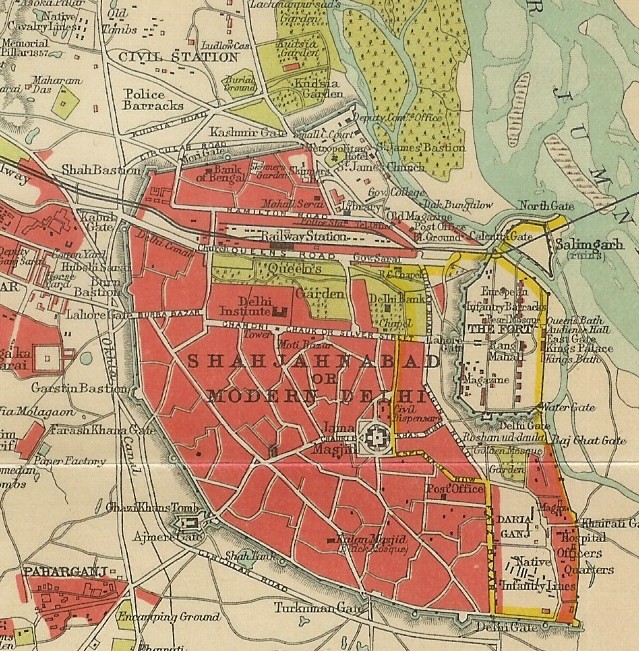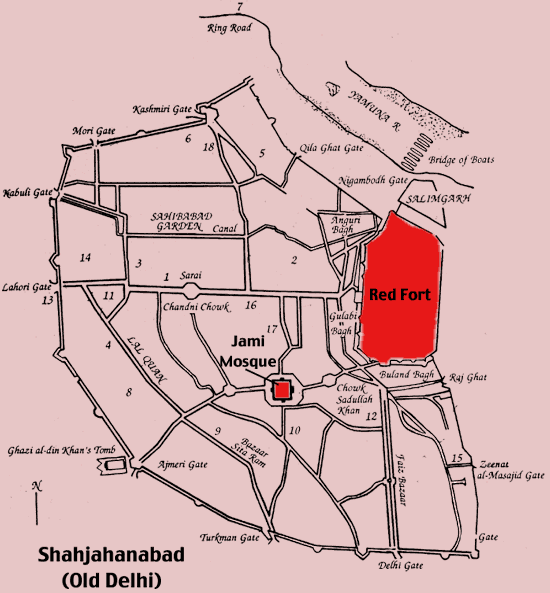

From Murray's Handbook for Travelers, 1906
Source: ebay, Apr. 2007

| 1. Chunna Mal's Haveli
2. Begum Samru's Haveli 3. Namak Haram ki Haveli 4. Zeenat Mahal's Haveli 5. The British Residency 6. Skinner's House |
7. Metcalfe's Haveli
8. Ahsanullah Khan's Haveli 9. Haksar Haveli 10. Matiya Mahal 11. Fatehpuri Masjid 12. Akbarabadi Masjid |
13. Sirhindi Masjid
14. Aurangabadi Masjid 15. Zinat al-Masajid 16. Sunahri Masjid 17. Masjid of Sharif ud-Daulah 18. Fakhr ul-Masajid |
Source: http://newton.uor.edu/facultyfolder/rebecca_brown/old/arth100/empire/Mughals/delhimapB.html
(downloaded Mar. 2006)
*Sections from a panoramic view from the Red Fort, 1846*
*A panoramic view south from the Jama Masjid (huge scans)*
The city consisted of 36 muhallahs, or quarters, the majority of which were named after the most renowned nobles of Delhi. "Amid these streets," writes Bernier, "are dispersed the habitations of mansabdars, officers of justice, rich merchants, and others; many of which have a tolerable appearance." Bernier then gives a description of a model "fine house" in Delhi, and proceeds to say:-- "The dwellings of the Omrahs, though mostly situated on the banks of the river and in the suburbs, are yet scattered in every direction.... A good house has its court-yards, gardens, trees, basins of water, small jets d'eau in the hall or at the entrance, and handsome subterraneous apartments, which are furnished with large fans.... A house to be greatly admired must be seated in the middle of a large flower garden, and should have four large divans, raised to the height of a man from the ground, and exposed to the four winds, so that the coolness may be felt from any quarter; indeed, no handsome dwelling is ever seen without terraces on which the family may sleep during the night. They always open into a large chamber into which the bedstead is easilymoved in case of rain.... The interior of a good house has the whole floor covered with a cotton mat. Five or six feet from the floor the sides of the room are full of niches, cut in a variety of shapes, tasteful and well proportioned, in which are seen procelain vases and flower pots. The ceiling is gilt and painted...."
With all that was so grand and costly, there was associated that form of undisguised poverty which results from despotism and an unequal division of power and wealth in a country. "Intermixed with these houses," writes Bernier, is an immense number of small ones, composed of earth and straw, in which lodge the common horsemen and all that vast multitude of servants and settlers who follow the court and the army."
--Carr Stephen, Archaeology and Monumental Remains of Delhi (Author,
1876), pp. 248-49
== Indian Routes index == Indian Routes sitemap == Glossary == FWP's main page ==